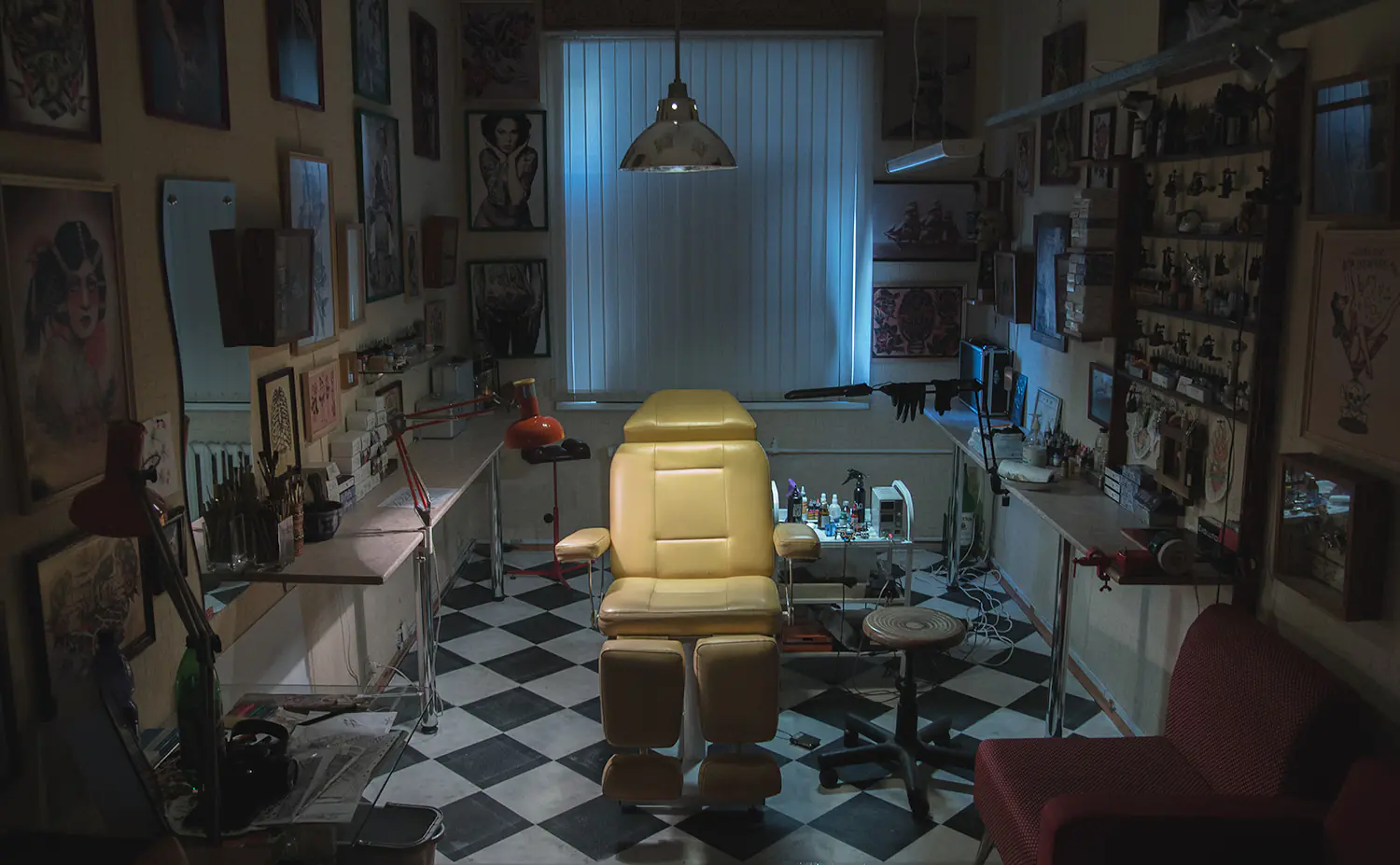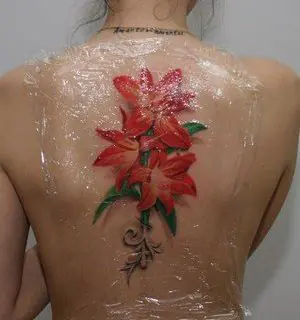The topic of tattoo healing is a hackneyed one, but new questions still arise about how to care for a tattoo. The answers to them must be found out before the start of the session in order to avoid infection or loss of brightness of the pattern. If you are just thinking about what to put on your body, be sure to read this article. In order to understand exactly what needs to be done and how, and whether you are ready for it.
Why you need to know how to care for a tattoo
The main and most important rule of tattoo care is consciousness. Regardless of the artist, the salon, or the size of the design, you should always take care of your tattoo.
Note. The process of tattooing itself is damage to the protective epithelium. The needle with ink penetrates under the top layer of skin, after which it begins to actively peel off.
Do you remember how you pinched your scratched knees as a child? The skin on them became tight with a film, or worse, a crust, and later began to become rough and itchy. If you accidentally tear off the top layer of the wound, then under the crust you will find tender skin that has not yet healed. There was a possibility of scar formation. This is approximately how things are with a new tattoo.
It is in the first days after tattooing that you need to pay attention to the condition of the skin. If it is taken with a film or, even worse, a crust, then the probability of removing the latter along with the paint is very high. There is a risk of suppuration.
Important! If pus forms, a visit to the doctor cannot be avoided, and a beautiful tattoo should be forgotten for a very long time, if not forever. That is why it is necessary to adhere to certain rules!
Caring for a tattoo in the first days after application
To obtain an excellent drawing, you need an experienced craftsman and, of course, a good healing cream. There are a lot of the latter in the world, but most often the masters advise which one is better, since they have already encountered the healing process more than once.
For the first couple of days, ichor will collect over the tattoo. This is the epidermis actively trying to expel everything foreign from the body.
The ichor appears almost immediately after the tattoo is applied. If you do not wrap the area of skin and do not lubricate it, then after some time the ichor will dry out and simply stick to the tissue that will be adjacent to it. Tearing off this area of skin will be very difficult and painful.
Therefore, certain actions should be taken to help avoid skin injury.
Algorithm of actions after a tattoo session
- wash your hands with antibacterial soap;
- carefully remove the bandage;
- Gently rinse the tattoo area without pressing;
- blot with a napkin or let dry on your own;
- apply healing cream;
- make a bandage out of a diaper, which is secured with tape or film.
If the bandage is secured with film, it should not be done very tightly. The tattoo must breathe, but the film, due to its properties, does not allow this to happen. The diaper will not only help the pores open, but will also absorb some of the paint that will stand out. In addition, the remains of cream, paint and ichor can ruin clothes.
Some experts allow you to walk without a bandage at home, after a shower and in clean and loose clothes. This will promote healing.
Before going outside, be sure to apply a bandage. Because not only dust, but also exhaust gases can have a detrimental effect on a tattoo.
Care actions in the first days should be continued for a week. This will help the skin recover and completely avoid infection. In addition, if you wear such a compress, the skin will not dry out, so the paint will adhere better and will not fade too much.
A week after getting the tattoo, you should stop applying the bandage. For the next 7 days, you need to wash and lubricate the tattoo on average three to four times a day. Bandaging should be avoided. During the late healing period, the body must breathe fully. If you block the access of oxygen, the skin will begin to dry out and peel off.
Features of tattoo healing
The most important period after getting a tattoo is the first three to four days. At this time, you should pay maximum attention to the skin and pattern, otherwise the result will be much worse than expected.
In the first few days, the tattoo is covered with a film. Thanks to the use of healing cream, it remains very thin. If the film is thick and rough, the drawing will be slightly distorted, and some of the paint will go away with it. Therefore, it is necessary to monitor dry skin; during this period it should remain soft enough.
After active healing, a thin film of skin over the tattoo begins to peel off. This is a natural process that should not be scary. As a result of the fact that ink was applied under the skin, its integrity was violated. In this regard, it is completely natural that the top layer of skin will die. Don't be afraid when it starts.
Moreover, there is no need to call the specialist with cries for help and accusations that the skin is peeling off. You just need to wait until the epidermis layer is restored naturally.
When the film begins to actively fall off, there is no need to tear it off under any circumstances. This will disrupt the skin's natural defenses and lead to uneven healing. Remember knees and prematurely torn scabs from wounds. Many of them turned into scars and remained forever.
A couple of days after application, the tattoo begins to actively itch. This is perhaps the most difficult period that needs to be endured. You should never scratch a tattoo. In the best case scenario, an area of skin will simply be affected, and the paint will not adhere properly there. At worst, the wound becomes infected from bacteria from the hands and festers.
After the top layer of skin peels off, the tattoo will become much paler than at first. You shouldn't be afraid of this either:
- firstly, the epidermis was partially renewed, but the basic ink remained at a deeper level;
- secondly, if the artist did everything correctly, then after 3-4 days the tattoo will take on the required color.
Note! Tattoo artists specifically make the colors much more expressive when applied, so that after removing the film, the design acquires the required shade.
With proper work by the artist, the pallor of the tattoo will disappear in a few days, the skin will continue to renew itself and the colors will fully regain their brightness. That is why it is worth knowing how to properly care for a tattoo. Without a sequence of a specific set of actions, the result can be not only pale, but also painful. It is worth remembering about suppuration that occurs due to improper care.
What not to do when caring for a tattoo?
Prohibitions for the first days after tattooing, in addition to those listed above, are as follows:
- you cannot visit the bathhouse/sauna;
- hit the tattoo site;
- it is necessary to avoid going to the gym;
- do not drink alcohol;
- Avoid sunbathing and visiting the pool and sea.
If all the prohibitions are understandable, then the contraindications to alcohol are a little confusing for a beginner. This fact can be explained simply. When you drink alcohol, your blood pressure rises and your body begins to actively eliminate it. This also happens through the pores. In our case, the area of skin with a tattoo is very vulnerable, so sweat can negatively affect the healing process.
Avoiding the sun is necessary to avoid drying out your skin. In addition, the dark shade of the body makes the tattoo much less bright. The sun's rays kill the richness of the pigment used in ink. This is why tan lovers have to have their tattoos corrected much more often than those who avoid ultraviolet radiation.
A reliable sunscreen remains your salvation from the sun. It must be used according to the instructions or even a little more often. These simple steps will keep your tattoo bright and attractive longer.
How to care for a tattoo: to summarize
Tattoos require attention, so you can't just get them and forget them. If you do not properly care for the drawing in the first few days, the result will be obvious.
First of all, wounds may form. They will be minor, but healing will slow down. A feature of such wounds will be their centering at the end. This is where a white spot is formed, not covered with paint. This is the dermis that should be inked with tattoo ink. If healing is improper, this does not happen; the dermis is completely renewed, leaving a white spot in the center of the wound.
If you correctly understand how to care for a tattoo, you can not only avoid complications, but also enjoy an excellent design for a long time that will not require correction. Everything depends on desire and consciousness.
But if you ignore advice on tattoo care, you can get suppuration, injury and a destroyed tattoo.

Caring for a tattoo in the first days after application
You have finally become the proud owner of a new and fresh tattoo. Congratulations! But now the most important and responsible stage begins - Tattoo care!
Caring for a tattoo in the first days is an extremely important stage in preserving the tattoo in its ideal form, ensuring that the work matches the original sketch, as well as its proper healing, which depends solely on you. The masters of our salon will advise you in detail and in detail about the rules and subtleties of tattoo care. Complete engraftment of the paint, ideal drawing of lines and contours, preservation of all details of the design - all this depends on the efforts you make to follow all the instructions of the master for ideal healing and care of the tattoo after application.
Each master in each salon has his own individual care recommendations, but they agree on the basic rules.
We have prepared for you a detailed memo on all the rules of care from the Tatula studio:
For perfect tattoo care you will need:
- Antibacterial, baby or laundry soap, liquid or regular.
- Chlorhexidine bigluconate solution.
- Ointment for tattoo healing. The most popular positions recommended by experts are:
- "Methyluracil"
- "Dexpanthenol"
You can choose any one.
Dry wipes or paper towels. Children's pharmacy absorbent diaper or universal towels in a roll of non-woven material. A patch for securing the diaper, tape will also work. Patience, accuracy and responsibility.Instructions for caring for the tattoo after application:
- So, after the tattoo session, the master puts a protective bandage on the fresh tattoo, which must be worn for 1 to 4 hours. After which you need to remove it and wash the work with water to remove the released ichor; it is good to use antibacterial or baby soap. The redness of the work will last a couple of days, there may be a slight release of paint, this is completely normal.
- After you have washed the tattoo with soap, you need to blot the work with an antibacterial compress with a solution of chlorhexidine digluconate.
- Dry the work with a napkin or a clean one! with a towel, gently blot it, do not rub it or wipe it roughly.
- Apply a thin layer of healing ointment.
- If your tattoo will not be exposed to external influences in the coming hours, such as: direct contact with clothing, sunlight, dust or dirt, then you can let the work “breathe” and not wrap it in a diaper; in all other cases, it is necessary to isolate the work from excess irritation and entry of bacteria and germs, using a diaper or non-woven roll towels, which can be secured with adhesive tape or adhesive tape.
- At night, be sure to isolate the tattoo with a diaper or non-woven roll towels and tape, having completed all the previously described procedures.
- Repeat all tattoo care steps AT LEAST 5 times a day for 3 days after application.
- On the 4th day after application, you can take care of the tattoo 3 times a day. It is necessary to follow all the points, but immediately after washing you can no longer use the Chlorhexidine bigluconate solution, but immediately start using the ointment.
As a rule, on the 4th day the tattoo is covered with a thin flaky film, and complete healing of the tattoo takes 10-14 days. For the first 7-8 days, the tattoo requires careful care, then you can only lubricate it with ointment so that the healing tattoo does not drag and does not peel off too much.
Until complete healing, it is strictly prohibited.
- Wash the tattoo with any alcohol-containing solutions.
- Scratch the healing tattoo, pick or rip off the flaky surface, rub with a washcloth or towel.
- Visit swimming pools, baths, saunas, public ponds, gyms and solariums, and also avoid too hot baths, which can lead to steaming of the tattoo.
- Cover the tattoo with various bandages and fabrics.
- The use of cling film should be avoided.
- Direct sunlight should be absolutely avoided.
- Avoid active physical activity.
While the tattoo is healing, it is recommended to wear loose, non-synthetic clothing.
Caring for a tattoo requires a responsible approach and patience, only then will your work be preserved in its perfect, original form.
Sign up for a Consultation right now by calling +7 (906) 536-22-22.
We will bring your wildest ideas and dreams to life.

The quality of the design depends on following the rules for caring for a fresh tattoo. In this case, the wound goes through different stages of healing with certain specifics.
How to properly care for a tattoo in the first days?
Immediately after applying the drawing, the master treats the affected area with an antiseptic and/or wound-healing agent. A transparent film is placed on top and secured with adhesive tape. Often they use regular cling film or an absorbent diaper from a pharmacy. However, the special film Suprasorb F produced in Germany is no less popular. It protects the skin from infection, but allows it to breathe and has a gas and vapor permeable structure. The film is coated with hypoallergenic adhesive, so additional fixation is not needed.
- this film allows you to take a shower, but not for long to avoid steaming the skin;
- in the first 1-3 days, liquid forms under the film - the wound dries out later on its own;
- Suprasorb F is removed 4 days (on the 5th) after drawing;
- To remove the film, the tattoo is steamed or heated with a hairdryer;
- after removing Suprasorb F, the tattoo is washed with water and liquid soap;
- Until complete healing, you need to lubricate the skin with Bepanten, Panthenol ointment or moisturizer.
- the film is removed after 6-12 hours (this is individual, you need to follow the recommendations of the specialist);
- the tattoo is washed with water and a small amount of liquid soap;
- blot the skin with a cotton swab and allow it to dry completely;
- apply ointment “Bepanten”, “Panthenol” or others and cover again with film;
- The entire procedure is repeated 2-3 times a day for the first three days.
How to care for a tattoo in the late healing period?

Proper care of a tattoo in the first days after application differs from the measures that must be taken in the next 2-3 weeks.
The Suprasorb F film is removed on the 5th day, and the regular film on the 4th. From this moment on, the healing process becomes more active and itching begins. It is important not to comb the pattern and keep it constantly moisturized. If the skin becomes covered with a film or crust and peeling begins, then do not interfere with this process. Everything “extra” will come off on its own.



